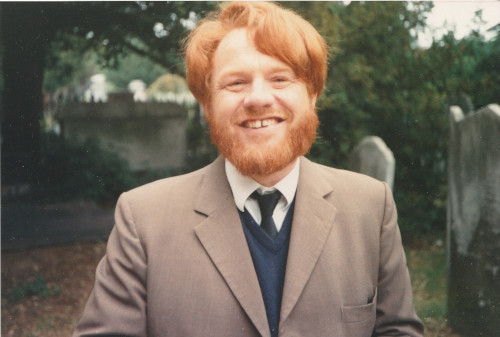 John Ponsonby (Photo courtesy of Ben Buxton)
John Ponsonby (Photo courtesy of Ben Buxton)
John Edward Basil Ponsonby
(Contributed by Ian Browne and Simon Lavington)
John was an electrical engineer, electronics expert and formidable physicist who worked at Jodrell Bank throughout his career. Born on 25th March 1939, his father was an English diplomat and John's mother numbered British, German and French nobility amongst her ancestors. As befitting for someone of his family background, John's education included attending a prep school followed by Marlborough, a prominent British public (i.e. private) school. A first indication of his future engineering prowess came while at school, when he and a fellow pupil were allowed to design and build a brick and stone bridge over a local stream as an alternative to doing sport. The bridge still stands.
John's first brief connection with radio astronomy came in the summer holiday of 1957 when, after leaving Marlborough, John became a temporary assistant to Tom Kaiser, a former Jodrell Bank radio astronomer and later the Professor of Space Physics at Sheffield University. After this John went on to Imperial College, London and graduated with a B.Sc. in Electrical Engineering. In the autumn of 1960 John embarked on his PhD in Radio Astronomy at Manchester University, working at what is now the Jodrell Bank Observatory in a group doing planetary and Moon radar observations. Following the premature death of his PhD supervisor John Thompson, John became de facto leader of this small group even before completing his PhD in 1969. His thesis describes radar observations of Venus at 408 MHz and 768 MHz whose primary objective was to establish an accurate value for the astronomical unit. It turned out that the group was not the first to do this, but not being one for false modesty, John was known to say "I wasn't the first person to bounce radiation off Venus. I was the first person to do it correctly!"
In the days before the Apollo missions to the Moon little was known about its surface properties. This prompted a major effort to map the Moon using low frequency radar to obtain information about the sub-surface structure. Along with John Thompson, John (P) developed the method of two-dimensional radar aperture synthesis in order to produce their map of the Moon at 162 MHz. To make successful observations John invented and built a fiendishly clever "Ephemeris Doppler Machine" to detect the returning radar echoes, automatically making allowance for changes in frequency. Also, during this productive time John helped develop one of the first digital autocorrelation spectrometers. With colleagues, John used it to make a measurement of the absorption due to neutral hydrogen in the radio signals from one of the first pulsars in order to estimate its distance.
For many of his later years at Jodrell Bank he worked on building a hydrogen maser frequency standard. John being a perfectionist set himself the task of building the World's best maser. In the process he taught himself lots of complicated physics and engineering but, though he briefly produced a working maser, the project was never completed.
John had many international friends and contacts. In 1971/72 he spent time at the Tata Institute of Fundamental Research, Bombay, and a whole year at Chalmers University of Technology, Sweden, in 1995/96. From time to time he made return visits to India (in 1983, 1991 and 1993) and to Sweden. John was also a member of several international committees. He was an active defender of the right of radio astronomers to use important sections of the radio spectrum. He wrote reports for the Scientific Committee on Frequency Allocations for Radio Astronomy and Space Research, which operates under the auspices of the International Council of Scientific Unions. John's determination to protect radio astronomical interests put him into conflict with international giants such as Motorola with their Iridium satellite phones, to the extent that he felt his personal safety might be threatened. We can only imagine how appalled he would be about Starlink and similar space activities!
John had a great awareness of his wider family - one of his oft-heard conversational remarks being along the lines of: "Ah, yes, he/she is a cousin of mine". For any Ponsonby John would usually have a story*. He was proud of his Ponsonby ancestors amongst whom numbered generals, bishops, diplomats, eccentrics and social reformers. John followed the family tradition by being a generous supporter of social reform charities.
Away from radio astronomy John was a keen sailor. He set high standards for himself and the people he dealt with which quite often brought him into conflict with authority and with bureaucracy, sometimes prompting the occasional angry outbursts. He was a man of huge personality and intelligence who could be charming, generous, intimidating, educational and funny, sometimes all in the course of a single conversation.
John died on 7th June 2021.
* John's family connection with new Zealand's favourite meat pie company "Ponsonby Pies" remains untold.
![[IAU logo]](iau_wb_thumb.jpg)
![[URSI logo]](URSI-logo-thumb.jpg)
![[Karl Jansky at his antenna]](jansky_photo_02_thumb.jpg)
![[Reber's Wheaton antenna]](Reber_Telescope_Wheaton_thumb.jpg)
![[Dover Heights]](Dover_Heights_02_thumb.jpg)
![[4C telescope]](GB61-195_4C_telescope_thumb.jpg)
![[Ewen and horn antenna]](ewen_horn1s.jpg)
![[Dwingeloo, 1956]](Dwingeloo-1956-thumb.jpg)
![[Jocelyn Bell Burnell and Cambridge antenna used in pulsar discovery]](burnell2_thumb.jpg)
![[Lovell Telescope at Jodrell Bank]](site_1594_0001-500-334-20180316163019-thumb150.jpg)
![[Wilson, Penzias, and Bell Labs horn antenna]](wilson-penzias-horn_thumb.jpg)
![[6-m Millimeter Radio Telescope in Mitaka, Japan]](6m-thumb.jpg)

